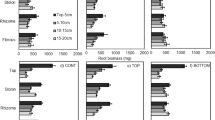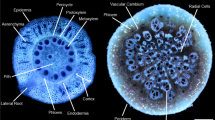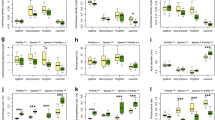Abstract
Low phosphorus availability is a primary constraint to plant productivity in many natural and agricultural ecosystems. Plants display a wide array of adaptive responses to low phosphorus availability that generally serve to enhance phosphorus mobility in the soil and increase its uptake. One set of adaptive responses is the alteration of root architecture to increase phosphorus acquisition from the soil at minimum metabolic cost. In a series of studies with the common bean, work in our laboratory has shown that architectural traits that enhance topsoil foraging appear to be particularly important for genotypic adaptation to low phosphorus soils (‘phosphorus efficiency’). In particular, the gravitropic trajectory of basal roots, adventitious rooting, the dispersion of lateral roots, and the plasticity of these processes in response to phosphorus availability contribute to phosphorus efficiency in this species. These traits enhance the exploration and exploitation of shallow soil horizons, where phosphorus availability is greatest in many soils. Studies with computer models of root architecture show that root systems with enhanced topsoil foraging acquire phosphorus more efficiently than others of equivalent size. Comparisons of contrasting genotypes in controlled environments and in the field show that plants with better topsoil foraging have superior phosphorus acquisition and growth in low phosphorus soils. It appears that many architectural responses to phosphorus stress may be mediated by the plant hormone ethylene. Genetic mapping of these traits shows that they are quantitatively inherited but can be tagged with QTLs that can be used in plant breeding programs. New crop genotypes incorporating these traits have substantially improved yield in low phosphorus soils, and are being deployed in Africa and Latin America.
Similar content being viewed by others
References
Abeles F B, Morgan P W and Saltveit M B 1992. Ethylene in Plant Biology. Academic Press, Inc., San Diego.
Bacanamwo M and Purcell L C 1999 Soybean root morphological and anatomical traits associated with acclimation to flooding. Crop Sci. 39, 143–149.
Bates T and Lynch J P 1996 Stimulation of root hair elongation in Arabidopsis thaliana by low phosphorus availability. Plant Cell Environ. 19, 529–538.
Bonser AM, Lynch J and Snapp S 1996 Effect of phosphorus deficiency on growth angle of basal roots in Phaseolus vulgaris. New Phytol. 132, 281–288.
Borch K, Bouma T J, Lynch J P and Brown K M 1999 Ethylene: A regulator of root architectural responses to soil phosphorus availability. Plant Cell Environ, 22, 425–431.
Borlaug NE 1972. The green revolution, peace, and humanity. Speech delivered upon receipt of the 1970 Nobel Peace Prize. CIMMYT reprint and translation series No. 3. Centro Internacional de Mejoramiento de Maiz y Trigo, El Batan, Mexico.
Cathcart J B 1980 World phosphate reserves and resources. In The Role of Phosphorus in Agriculture. Eds F B Khasawneh, B C Sample and E J Kamprath. pp 1–18. American Society of Agronomy, Crop Science Society of America, Soil Science Society of America, Madison, WI.
Chadwick A V and Burg S P 1967 An explanation of the inhibition of root growth caused by indole-3-acetic acid. Plant Physiol. 42, 415–420.
Chu W and Chang S 1966 Surface activity of inorganic soil phosphorus. Soil Sci. 101, 459–464.
CIAT 1999 Bean project 1998 annual report. Working document number 179. CIAT, Cali, Colombia.
Coutts M P and Nicoll B C 1993 Orientation of the lateral roots of trees. II. Hydrotropic and gravitropic responses of lateral roots of Sitka spruce grown in air at different humidities. New Phytol. 124, 277–281.
Drew M, He C and Morgan P 1989 Decreased ethylene biosynthesis, and induction of aerenchyma, by nitrogen-or phosphatestarvation in adventitious roots of Zea mays L. Plant Physiol. 91, 266–271.
Drew MC and Saker L R 1978 Nutrient supply and the growth of the seminal root system in barley. J. Exp. Bot. 29, 435–451.
Eissenstat D 1992 Costs and benefits of constructing roots of small diameter. J. Plant Nutr. 15, 763–782.
Eissenstat D 1997 Trade-offs in root form and function. In Ecology in Agriculture. Ed. L Jackson. pp 173–199. Academic Press, San Diego.
Enwezor and Moore A 1966 Phosphorus status of some Nigerian soils. Soil Sci. 102, 322–328.
Evans ML 1991 Gravitropism: Interaction of sensitivity modulation and effector redistribution. Plant Physiol. 95, 1–5.
Firn R D and Digby J 1997 Solving the puzzle of gravitropism - has a lost piece been found? Planta 203, S159–S163.
Fitter A H 1991 The ecological significance of root system architecture: An economic approach. In Plant Root Growth: An Ecological Perspective. Ed D Atkinson. pp 229–243. Blackwell, Oxford.
Gahoonia T S, Nielsen N E and Lyshede O B 1999 Phosphorus (P) acquisition of cereal cultivars in the field at three levels of P fertilization. Plant Soil 211, 269–281.
Ge Z, Rubio G and Lynch J P 2000 The importance of root gravitropism for inter-root competition and phosphorus acquisition efficiency: Results from a geometric simulation model. Plant Soil 218, 159–171.
Glick B, Patten C, Holguin G and Penrose D 1999. Biochemical and Genetic Mechanisms Used by Plant Growth Promoting Bacteria. Imperial College Press, London.
Harpham N, Berry A, Knee E, Rovedahoyos G, Raskin I, Sanders I, Smith A, Wood C and Hall M 1991 The effect of ethylene on the growth and development of wild-type and mutant Arabidopsis thaliana (L.) Heynh. Ann. Bot. 68, 55–61.
Harrison M A and Pickard B G 1989 Auxin asymmetry during gravitropism by tomato hypocotyls. Plant Physiol. 89, 652–657.
He C J, Morgan P W and Drew M C 1992 Enhanced sensitivity to ethylene in nitrogen-starved or phosphate-starved roots of Zea mays L. during aerenchyma formation. Plant Physiol. 98, 137–142.
Hobbie L and Estelle M 1994 Genetic approaches to auxin action. Plant Cell Environ. 17, 525–540.
Hodge A, Robinson D, Griffiths B S and Fitter A H 1999 Why plants bother: Root proliferation results in increased nitrogen capture from an organic patch when two grasses compete. Plant, Cell Environ. 22, 811–820.
Keter J and Ahn P 1986 Profile characteristics, and form and surface activity of inorganic phosphorus in a deep red Kenya coffee soil (nitosol). J. Soil Sci. 37, 89–97.
Konings H and Jackson M B 1979 A relationship between rates of ethylene production by roots and the promoting or inhibiting effects of exogenous ethylene and water on root elongation. Z. Pflanzenphysiol. 92, 385–397.
Liao H, Rubio G, Yan X, Cao A, Brown K M and Lynch J P 2001 Effect of phosphorus availability on basal root shallowness in common bean. Plant Soil 232, 69–79.
Liu J H and Reid D M 1992 Auxin and ethylene-stimulated adventitious rooting in relation to tissue sensitivity to auxin and ethylene production in sunflower hypocotyls. J. Exp. Bot. 43, 1191–1198.
Lorbiecke R and Sauter M 1999 Adventitious root growth and cellcycle induction in deepwater rice. Plant Physiol. 119, 21–29.
Lynch J M, Ed 1990 The Rhizosphere. John Wiley & Sons, New York.
Lynch J 1998 The role of nutrient efficient crops in modern agriculture. J. Crop Production 1, 241–264.
Lynch J and Brown K 1998 Root architecture and phosphorus acquisition efficiency in common bean. In Phosphorus in Plant Biology: Regulatory Roles in Ecosystem, Organismic, Cellular, and Molecular Processes. Eds. J Lynch and J Deikman. pp 148–156. American Society of Plant Physiologists, Rockville, MD.
Lynch J and Brown K M 1997 Ethylene and plant responses to nutritional stress. Physiol. Plant 100, 613–619.
Lynch J and Deikman J, Eds 1998 Phosphorus in Plant Biology: Regulatory Roles in Ecosystem, Organismic, Cellular, and Molecular Processes. American Society of Plant Physiologists, Rockville, MD.
Lynch J, K Nielsen, Davis R and Jablokow A 1997 Simroot: Modeling and visualization of botanical root systems. Plant Soil 188, 139–151.
Lynch J P and Beebe S E 1995 Adaptation of beans (Phaseolus vulgaris L.) to low phosphorus availability. HortScience 30, 1165–1171.
Madlung A, Behringer F J and Lomax T L 1999 Ethylene plays multiple nonprimary roles in modulating the gravitropic response in tomato. Plant Physiol. 120, 897–906.
Manske G, Ortiz-Monasterio J, Van Ginkel M, Gonzalez R, Rajaram S, Molina E and Vlek P 2000 Traits associated with improved Puptake efficiency in CIMMYT's semidwarf spring bread wheat grown on an acid andisol in Mexico. Plant Soil 221, 189–204.
Marschner H 1995. Mineral Nutrition of Higher Plants. Academic Press, San Diego.
Miller C 1998. Root architecture of common bean (Phaseolus vulgaris L.): Adaptive nature and dynamic response to low phosphorus. Penn State University, M.S. Thesis.
Miller C, Nielsen K, Lynch J and Beck D 1998 Adventitious root response in field grown common bean: A possible adaptive strategy to low phosphorus conditions. In Radical Biology: Advances and Perspectives on the Function of Plant Roots. Eds. H Flores, J Lynch and D Eissenstat. pp 394–396. American Society of Plant Physiologists, Rockville, MD.
National Research Council 1989 Alternative agriculture Washington, D.C., National Academy Press.
Neumann G and Romheld V 1999 Root excretion of carboxylic acids and protons in phosphorus-deficient plants. Plant Soil 211, 121–130.
Nielsen K, Bouma T, Lynch J and Eissenstat D 1998 Effects of phosphorus availability and vesicular-arbuscular mycorrhizas on the carbon budget of common bean (Phaseolus vulgaris). New Phytol. 139, 647–656.
Niklas K 1995 Morphological evolution through complex domains of fitness. In Tempo and Mode in Evolution: Genetics and Paleontology Fifty Years after Simpson. Eds. W Fitch and F Ayala. pp 145–165. National Academy Press, Washington, DC.
Nissen P 1985 Dose responses of auxins. Physiol. Plant. 65, 357–374.
Oyanagi A 1994 Gravitropic response growth angle and vertical distribution of roots of wheat (Triticum aestivum L.). Plant Soil 165, 323–326.
Pothuluri J, Kissel D, Whitney D and Thien S 1986 Phosphorus uptake from soil layers having different soil test phosphorus levels. Agron. J. 78, 991–994.
Raab M M and Koning R E 1987 Changes in responsiveness to ethylene and gibberellin during corolla expansion of Ipomea nil. J. Plant Growth Regul. 6, 121–131.
Raghothama K 1999 Phosphate acquisition. Annu. Rev. Plant Physiol. Plant Mol. Biol. 50, 665–693.
Robinson D, Hodge A, Griffiths B S and Fitter A H 1999 Plant root proliferation in nitrogen-rich patches confers competitive advantage. Proc. R. Soc. Lond. Ser. B: Biol. Sci. 266, 431–435.
Roman G, Lubarsky B, Kieber J J, Rothenberg M and Ecker J R 1995 Genetic analysis of ethylene signal transduction in Arabidopsis thaliana: Five novel mutant loci integrated into a stress response pathway. Genetics 139, 1393–1409.
Smith K A and Robertson P D 1971 Effect of ethylene on root extension of cereals. Nature 234, 148–149.
Smith S and Read D 1997 Mycorrhizal Symbiosis. Academic Press, San Diego.
Snapp S S and Lynch J P 1996 Phosphorus distribution and mobilization in bean plants as influenced by phosphorus nutrition. Crop Sci. 36, 929–935.
Thung M 1990 Phosphorus: A limiting nutrient in bean (Phaseolus vulgaris L.) production in Latin America and field screening for efficiency and response. In Genetic Aspects of Plant Mineral Nutrition. Eds. N EI-Basan, M Dambroth and B Longman. pp 501–521. Kluwer Academic Publishers, Dordrecht, The Netherlands.
Tinker P and Nye P 2000 Solute movement in the rhizosphere. Oxford University Press, New York.
Trewavas A J 1982 Growth substance sensitivity: The limiting factor in plant development. Physiol. Plant. 55, 60–72.
Vartapetian B B and Jackson M B 1997 Plant adaptations to anaerobic stress. Ann. Bot. 79, 3–20.
Visser E J W, Bogemann GM, Blom C W PM and Voesenek LA C J 1996a Ethylene accumulation in waterlogged Rumex plants promotes formation of adventitious roots. J. Exp. Bot. 47, 403–410.
Visser E J W, Cohen J D, Barendse G W M, Blom C W PM and Voesenek L A C J 1996b An ethylene-mediated increase in sensitivity to auxin induces adventitious root formation in flooded Rumex palustris Sm. Plant Physiol. 112, 1687–1692.
Visser E J W, Heijink C J, Vanhout K J GM, Voesenek LA C J, Barendse G W M and Blom C W P M 1995 Regulatory role of auxin in adventitious root formation in two species of Rumex, differing in their sensitivity to waterlogging. Physiol. Plant. 93, 116–122.
Voesenek L A C J and Blom C W P M 1996 Plants and hormones: An ecophysiological view on timing and plasticity. J. Ecol. 84, 111–119.
Wortman C, Kirkby R, Eledu C and Allen D 1998. Atlas of common bean (Phaseolus vulgaris L.) production in Africa. CIAT, Cali, Columbia.
Zhang H and Forde B 1998 An Arabidopsis MAIDS box gene that controls nutrient-induced changes in root architecture. Science 279, 407–409.
Author information
Authors and Affiliations
Corresponding author
Rights and permissions
About this article
Cite this article
Lynch, J.P., Brown, K.M. Topsoil foraging – an architectural adaptation of plants to low phosphorus availability. Plant and Soil 237, 225–237 (2001). https://doi.org/10.1023/A:1013324727040
Issue Date:
DOI: https://doi.org/10.1023/A:1013324727040




